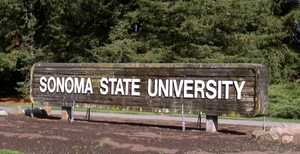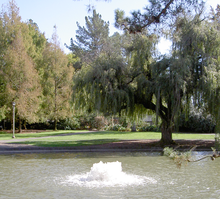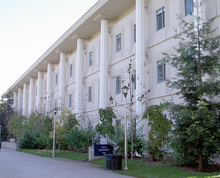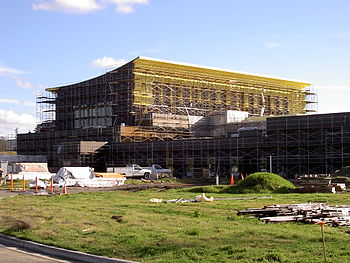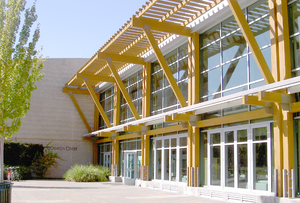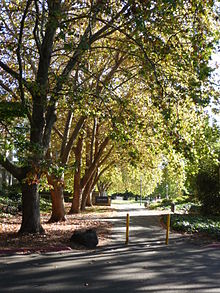- Sonoma State University
-
Sonoma State University 
Sonoma State University sealMotto Lux Mentis, Lux Orbis (Latin Motto in English Light of the Mind, Light of the World Established 1960 Type [Public university Endowment $26.0 million[1] President Dr. Ruben Armiñana Academic staff 542 Students 8500 Location Rohnert Park, California, United States Campus Suburban, 269 acres (109 ha) (main campus) Former names Sonoma State College (1960–1978) Colors Navy blue and Columbia blue Mascot Seawolves (formerly Cossacks) Affiliations California State University, COPLAC, CCAA Website sonoma.edu 
Sonoma State University is a public, coeducational business and liberal arts college affiliated with the California State University system. The main campus is located in Rohnert Park, California, United States and lies approximately 10 miles (16 km) south of Santa Rosa and 50 miles (80 km) north of San Francisco. Commonly called SSU, Sonoma State, and Sonoma, the university is one of the smallest of the 23 state university campuses in California. The university offers over 65 undergraduate and graduate degree programs and claims to be the most requested campus of the CSU system.[citation needed]
Contents
History
Founding
Sonoma State College, was established by the state legislature in 1960 to be part of the California State College system, later to become the California State University system. Classes offered by the university first opened to 250 students in June 1961 in leased buildings in Rohnert Park where the college offered its first four year Bachelor of Arts degree in Elementary Education. With the completion of its two main classroom halls, Stevenson Hall, named for politician Adlai Stevenson II and Darwin Hall, named for Charles Darwin, developer of the theory of Natural Selection, the college moved to its permanent campus of 215 acres (87 ha) in 1966 where the first graduating class received their degrees.[2]
Early development
As enrollment increased, the school built more on campus facilities including Ives Hall for performing arts, The University Commons for dining, a small library, and a gymnasium. These buildings followed the physical master plan of the school which stated that the facilities would be urban in character, defining the use of smooth concrete building façades with landscaped courtyards. Among the landscaping features added with these facilities were the "Campus Lakes", two small reservoirs located behind the Commons next to Commencement lawn, the site of the university's annual commencement ceremonies, and one lake near the housing facility, Beaujolais Village. The lakes are home to local waterfowl and have since become an important aesthetic feature of the campus.
In 1969, the academic master plan underwent a major revision as the first master's degrees in biology and psychology were offered. The new cluster school concept, coupled with an even more heightened appreciation of the rural environment, influenced the new physical master plan. First to exemplify this new plan was the residence facility of 1972 named Zinfandel, a "village" of inviting stucco and redwood structures. The new Student Health Center used a primarily redwood façade with a landscaped ground cover of wild roses and poppies. In 1975 Nichols Hall, was built as the newest classroom hall and named in honor of Sonoma's founding president Ambrose R. Nichols.
Early development of the modern campus came to a close in 1976 when the Student Union was constructed between the main quad and the lakes. This building continued the use of the physical master plan, using primarily redwood and preceding the similarly built Carson Hall, Art building, a childcare center, additional parking, and a computer center which was added on to the library.[2]
The modern university
In 1978 Sonoma State College became Sonoma State University when the school officially gained university status. In response to this achievement, the surrounding community provided funds for the new university to build a large swimming pool which was completed in 1982 and the 500-seat Evert Person Theatre which was completed in 1989 and dominates the view when entering campus through the main drive. Further enrollment increases and a new goal of movement toward a residential campus as opposed to a commuter campus facilitated the building of Verdot Village in 1995.[2]
Recent and future expansion
In May 2000, the Board of Trustees approved a new master plan, which added 48 acres (19 ha) to the campus. Rapidly accelerated growth of the residential student body was alleviated by the construction of the third phase of on-campus housing named Sauvignon Village, offering housing to non-freshmen students. In the same year, the Jean and Charles Schulz Information center was completed to accommodate the expanded needs of the library and computing services. The state-of-the-art, high technology facility was built as a prototype library and information complex for the 21st century, housing more than 400,000 volumes in its stacks. The center also houses an advanced Automated Retrieval System (ARS) which houses an additional 750,000 volumes in a computer managed shelving system in the library wing. A large portion of the funding to build the information center was donated by Charles Schulz, cartoonist and author of the popular Peanuts comic series, and his wife Jean.
In October 2003, Beaujolais, the youngest of the residential villages was completed, offering another 655 beds to the rapidly expanding student body. The addition of this new village had made Sonoma State the most residential campus in the CSU system housing more students then any of its affiliates. It is anticipated that a new phase of student housing, Tuscany Village, expected sometime before 2010, will bring nearly 700 more beds to the campus This project was approved at the May 2007 meeting of the board of trustees and will bring Sonoma's number of residential students to 3,100.
To support the current residential population of the campus, a student-financed Recreation Center was completed in fall 2004 and now acts as a social center and meeting place for a large portion of the Student body. Because of the new and innovative recreation center, the university was awarded an Outstanding Sports Facilities Award by the National Intramural Recreational Sports Association in 2005.
In January 2005, the university began the renovation of Darwin Hall, the now 40-year-old science building. The new 21st century building was designed to provide efficient academic classrooms and study areas for faculty and their students. The renovated building was completed and re-opened in fall 2006 and provides new laboratories and classrooms to support the needs of modern science curriculum. Like all new and renovated buildings at Sonoma State, Darwin Hall is a model of energy efficiency.[3]
The new property approved by the board of trustees in 2000 is the site of the Donald and Maureen Green Music Center, funded by private donors, currently under construction to be completed in 2012. A component of the Green Music Center, Music Education Hall, was state-funded. Students began taking classes and occupying the building in Fall 2008. The Center has been planned as an architectural ensemble of the finest acoustical quality designed to enhance and emulate the groves, vineyards, and rolling foothills of Sonoma County. It will be the new home of the Santa Rosa Symphony Orchestra.
A new social center for the university won approval in April 2011 by a vote of the students to raise their fees by $150 a semester to cover the cost. The Student Center will be a new home for the campus bookstore, dining hall, student meeting space, a conference center, and student government offices. Construction of the $65 million facility will begin adjacent to the Recreation Center.[4]
Presidents
The office of the president began with the university's founding in 1960 when Ambrose R. Nichols, Jr. acted as the founding president of the university. There have been a total of six presidents of Sonoma State University:[2]
Presidents of SSU Years as President 1 Ambrose R. Nichols, Jr. (1960–70) 2 Thomas H. McGrath (1971–74) 3 Marjorie Downing Wagner (1974–76) 4 Peter Diamandopoulos (1977–83) 5 David W. Benson (1984–92) 6 Ruben Armiñana (1992–Present) Campus
Demographics of student body Undergraduate African American 2.1% Asian American 5.2% White American 66.5% Hispanic American 11.8% Native American 0.8% International 1.1% Ethnicity unreported/unknown 12.4% Sonoma State occupies approximately 269 acres (109 ha) on the east side of the main suburban area of Rohnert Park. Directly adjacent to the main campus is the popular, Wolf's Den plaza, a popular hang out and eating area of SSU students. One of the most requested campuses in the CSU system and regularly named a "Best Value" College by Princeton Review. The Princetom Review has also named SSU one of 12 of the nation's most "green" campuses.[5] SSU has also been named one of the "most wired" campuses in the nation by Forbes magazine.
The original buildings of the university and those built in the same style, namely, The Student Union, The University Commons, Evert Person Theatre, and Stevenson, Darwin, Ives, Nichols, and Carson Halls, were all designed to accentuate an appreciation for urban architecture. As such, the buildings are all constructed using mainly smoothed or exposed aggregate concrete with some buildings preferring primarily redwood siding. The residential villages, though they were meant to continue in this tradition, show the first movements away from this plan as they employ stucco siding with terra cotta tile roofs.
Moving further from the original plan are Salazar Hall, the Schulz Information Center, and the Campus Recreation Center. These buildings mark a notable movement toward sustainability and modernized architectural aesthetics as opposed to the smooth concrete buildings of the past that were allegedly designed by an architect known for the designs of several women's prisons.
Campus Recreation Center
The 59,000-square-foot (5,500 m2) Recreation Center has become a model for sustainability. The center was recognized for a state-of-the-art design that maximizes functional space and demonstrates numerous efforts incorporating sustainable building techniques while using a selection of materials which reflect the surrounding rural county. Sustainable materials include the use of heat and UV ray reflective roofing, recycled rubber indoor track, recycled glass reinforced structural brick, recycled seat belts to upholster seating, and reclaimed water plumbing non-potable water systems. This reclaimed water plumbing makes this the first and largest building in Sonoma county to use such a system.
The Rec Center houses a large gym with fixed weight machines and free weights, a wide selection of aerobic and cardiovascular training equipment, an indoor track, climbing wall, exercise and dance studios, multiple basketball courts an indoor soccer court, billiards tables, locker rooms, massage studio and a spa.
University Library
The Jean and Charles Schulz Information Center is one of the largest libraries in the CSU system and the state of California with a 400,000 volume general collection and with a 750,000 volume automated retrieval system capacity. The library opened in 2000 and now stands as one of the largest buildings in the university.
The three story, 215,000-square-foot (20,000 m2) library is separated into two wings housing different areas on each floor. The building has a total of 5 acres (2.0 ha) of indoor floor space and 50,000 feet (15,000 m) of shelving. There are over 1,000 seats for students to study and an outdoor study patio on the third floor, which is also the "quiet floor" where absolutely no talking is allowed for those who prefer to study in complete silence. The library also houses a valued collection of writings and original letters from Jack London, as well as memorabilia relating to his works.
The $41.5 million building is named after Charles M. Schulz, the famed creator of the Peanuts comic cartoon, and his wife Jean who donated $5 million to help build and furnish the structure.[6] An additional $2.3 million went into furniture and equipment. The library is also well known for its mural honoring Cesar Chavez that can be found in the first floor.
The Green Music Center
The $120 million Donald and Maureen Green Music Center remains under construction. Music Education Hall (one of 4 components) opened its doors in 2008 to students who take classes in the two 60-person classrooms. The focal point of the Green Music Center is a 1,400-seat concert hall featuring precision engineered, world-class acoustics. The entire rear wall of the hall will open to lawn seating for a total of 10,000 additional guests.[7][8] The Hospitality Center, which includes a restaurant/executive conference center, opened in 2010. A $12 million donation from Joan and Sandy Weill, announced in March 2011, will provide the funds to complete the Concert Hall for a fall 2012 opening. Fundraising continues for Schroeder's Recital Hall.[9]
Campus Bookstore
The Sonoma State Bookstore was operated by Sonoma State Enterprises, Inc. until the spring of 2006 when the operation was outsourced to Barnes & Noble College Booksellers despite some opposition from faculty members.[10] The Seawolf Shops will be moved into the new Student Center upon its completion.
Natural features
The Sonoma State campus blends man-made buildings with the natural plant life of the area. Large redwood trees are visible from nearly all vantage points on campus. Through the middle of the 269 acres (109 ha) the campus flows Copeland creek, which runs in and along the west side of Zinfandel Village, through the schools butterfly gardens, exiting campus near the site of the Green Music Center. The University Lakes occupy part of the north side of campus near the creek and are home to the Grand Willow (sometimes written as Grandwillow). The Grand Willow is one of the oldest trees on the Sonoma State University campus, planted during the original landscaping and development. For many of those in the SSU community, the Grand Willow represents the beginning of Sonoma State's growth from a small and relatively unknown college to the reputable university that it is today. It is for this reason that the tree was given its name, a play on the word Grandfather/Grandmother and befitting of its long life on the campus.
Off-campus sites
In addition to the main campus, the university also owns and operates two off campus study sites for students of the natural sciences. The first site is the 411-acre (166 ha) Fairfield Osborn Preserve located on nearby Sonoma Mountain.[11] The second site is the 3,200-acre (1,300 ha) Galbreath Wildlands Preserve in Mendocino County.[12] Both offer opportunities for research and hands-on education to students of the university. The University also offers students the opportunity to obtain their bachelor's degree in liberal arts through classes offered at Napa Valley College.
Academics
Sonoma State is thought of as a liberal arts university though it is known also for its strong schools of business and economics and nursing. The most popular schools of study by enrollment are business, liberal arts, and psychology. The school operates on the semester system with fall, spring, summer semesters and a short winter term, and short August term called "intersession".
Schools and special programs
The more than 65 departments and academic programs are divided into seven distinct schools, all offering undergraduate and graduate degrees and courses and nearly all offering minors and doctorates.
- School of Arts & Humanities
- School of Business & Economics
- *Wine Business Program
- School of Education
- School of Science & Technology
- Fairfield Osborn Preserve
- Galbreath Wildlands Preserve
- *Sonoma State Observatory
- School of Extended Education
- Certificate Programs
- Contract Credit Programs
- EXCEL for Youth
- Osher Lifelong Learning Institute
- Liberal Studies BA Degree Completion Program
- MA in Interdisciplinary Studies: Action for a Viable Future
- Art Therapy
- Depth Psychology
- Organization Development Program
- MS in Computer and Engineering Science
- Open University
- Sonoma State American Language Institute
- MA in Spanish
- Summer Session
- School of Social Sciences
- Anthro Studies Center[13]
- Other Majors
- California Cultural Studies
- Interdisciplinary Studies Special Major
- Special Major in Global Studies
- Planning
- Other Minors
- Career Minor in Women's Health
- Interdisciplinary Studies Special Minor
- Women's and Gender Studies
Accreditations and honors
Sonoma State is accredited by the Western Association of Schools and Colleges. Several of the schools within Sonoma State also have additional accreditations such as the School of Business and Economics which is accredited by the Association to Advance Collegiate Schools of Business, one of the world's most prestigious accreditors of business school programs.
In addition to Accreditation the school is also the only California university that is a member of the Council of Public Liberal Arts Colleges, the prestigious group of 19 universities and colleges across the nation that are often described as the "Public Ivies".
Hutchins School of Liberal Studies
The Hutchins School of Liberal Studies[14] is a nationally known interdisciplinary learning community within the larger institution of Sonoma State University. It emphasizes small classes, seminar process, and student empowerment. For lower division students, Hutchins offers an integrated General Education Program which provides a basic foundation for most majors at SSU. This program consists of one class taken each semester counting for 12 units and satisfying the students' General Education requirements in two years. Upper division students are able to use the Hutchins program in order to complete an inter-disciplinary B.A. in Art in Liberal Studies, a B.A. in elementary education, or an accelerated program offering students to complete both a B.A. in elementary education and a teaching credential program in four years. The faculty of the Hutchins School come from a variety of disciplinary backgrounds including Psychology, Anthropology, Physics, American Studies, History, Engineering, History of Science, Art History, Film Studies, and Comparative Literature. The current Director of the Hutchins School is Professor Eric McGuckin. The associated Hutchins Institute for Public Policy Studies (HIPPS) oversees the Interdisciplinary Master's program "Action for a Viable Future," as well as serving as an institutional home for various groups working toward social justice and environomental sustainability. HIPPS is currently under direction of professor Francisco Vazquez.
Wine Business program
Sonoma State's location in the California Wine Country allows the school to offer unique courses in the study of Wine Business and viticulture. While other universities have programs that emphasize grape growing and wine making, Sonoma State's program offers a specialized curriculum targeted on the business challenges of the wine industry. Courses are offered in Wine Marketing, Wine Finance and Accounting, Human Resources Management, Wine Business Strategies and Wine Production, Operations & Distribution.[15]
Department of Engineering Science
In response to the needs of the North Bay high tech industry, Sonoma State University has established a new Department of Engineering Science. The new department includes graduate and undergraduate programs with emphasis in electronics, computer hardware and software systems, photonics, and telecommunications. With the support of the local industries and community, the department's new laboratories located in the Cerent Engineering Science Complex are equipped with state-of-the-art instruments to conduct study and research.[16]
Controversies
In the spring of 2005, the Learning Disability program at SSU was under investigation by the Department of Education, Office of Civil Rights Case # 09-05-2100, for failing to meet Americans with Disabilities Act of 1990, Title II. The Office of Civil Rights found Disable Student Services accommodations policy in violation of Title II.
In May 2007, SSU faculty voted no confidence in President Armiñana based upon financial issues surrounding the building of the Green Music Center,[17] and faculty allegations that the building of the center took money away from academic programs. The center, originally intended to be a $10 million project, grew into a $120 million complex as additional venues and features were added to the original plan. In fact, the construction of the Center was initially funded by bond measures, loans and private donations[7] as the use of academic funds for other uses is illegal. The Board of Trustees continues to support Armiñana despite the vote.[18]
In February 2010, the FBI and investigators from the Sonoma County District Attorney's offices raided the campus's administrative and finance offices, seizing dozens of boxes from a storage area, as well as examining computers. The operation focused on an alleged misuse of federal grant money by the California Institute for Human Services (CIHS),[19] a unit closed by SSU in 2007. The two top CIHS administrators were dismissed at that time.[20]
Student life
Athletics
Sonoma State's teams compete in intercollegiate athletics as the Sonoma State Seawolves. The school's traditional colors are Navy, Columbia, and White. SSU athletic teams participate in the California Collegiate Athletic Association, an association within the NCAA's Division II. The official colors of the university are Navy Blue and Columbia Blue. Sonoma State is best known in intercollegiate athletics for strong baseball and soccer programs while winning national, state and individual athletic titles in nearly all sports at the school. Sonoma State's Baseball team is particularly noteworthy with repeated conference championships, 28 players drafted to major league teams since the year 2000 and 68 players drafted since records began in 1975. Three NCAA national championships won by women's soccer in 1990, men's soccer in 2002, and men's golf in 2009 also highlight SSU's athletic achievements. In 2008 the athletics department created the Seawolf Sports Network, allowing home basketball games to be broadcast via streaming video over the internet in an effort to further increase interest in its sports programs.
Sonoma State also has a strong club sport program led by lacrosse, 2002 USLIA National champions, and rowing. In 2008 the Mens Volleyball Club finished as runner up at the National Championships.
Mascots and the Cossack controversy of 2000
 Former Logo of the Sonoma State University Cossacks.
Former Logo of the Sonoma State University Cossacks.
The Sonoma State mascot is Lobo the Seawolf, lobo being Spanish for "wolf". The mascot is derived from the Jack London novel entitled The Sea-Wolf in which the protagonist is pressed into service aboard a boat captained by a man named "Wolf". The mascot was taken from the book for London's ties with Sonoma County, specifically the nearby town of Glen Ellen. Some resent the fact that the mascot is not a representation of a real animal and sometimes choose to equate it more readily to the Seawolf class attack submarine in the United States Navy.
The previous mascot of Sonoma State University was the Cossack, an eastern European community of fur traders known for superior horsemanship and ferocity in battle. The Cossacks held ties to the area through the 1812 fur trading posts at Fort Ross. This mascot was to be removed in the fall of 2002 by a vote of the academic senate after the mascot was deemed offensive to Jewish and women's groups on campus. This being due to the fact that Cossacks were reportedly notorious for historically oppressing Jewish people and women.
Various groups and individuals proposed new mascots such as the Rain Devils, Killer Bees, Trailblazers, Blue Wave, Blue Storm, and Condors as well as the Beagles in a nod to local legend and Peanuts creator Charles M. Schulz. Ultimately non-binding surveys and the final decision by then president Ruben Armiñana favored the Seawolf as the new representation of the university.
Student housing
Student housing at SSU has been applauded as some of the most comfortable dormitories in the state and even the country. Dormitories abandon the traditional use of high rise buildings and instead divide housing into distinct "villages" to promote a more comfortable and intimate residential experience. There are currently six residential villages on campus — Zinfandel, Cabernet, Verdot, Sauvignon, Beaujolais, and Tuscany.
Zinfandel and Cabernet Villages are the oldest of the five villages. These dormitories, as well as the Verdot Village, are intended solely for the housing of freshmen, with social buildings such as the cafeteria, Zinfandel Market, and pool centrally located within the Zinfandel Courtyard. Each village is divided into five to seven buildings, each of which are divided into suites with rooms and common areas.
Sauvignon, Beaujolais, and Tuscany Villages are the three newest dorm villages. Each offers the same suite style dormitories as the older villages with the addition of kitchens in each suite.
Campus life
Associated Students, Inc.
Associated Students, Inc. (ASI) is a student-run and student-owned organization that represents the goals and interests of the student population. The ASI Senate is the student government and board of directors of the corporation. ASI also encompasses two smaller divisions, Associated Students Productions (ASP) which plans and produces on-campus concerts and student events and Join Us Making Progress (JUMP) which organizes community service programs.
Associated Students, Inc. held a protest in March 2006 when the Academic Senate refused to allow them a vote on academic senate agenda items, many of which directly affect the education of SSU students. The academic senate never officially recognized the protest and continue to deny an official vote to ASI though their unofficial opinions and positions are taken into loose consideration in the decision making process. This is considered an oddity in the California State University as the remaining 22 other campuses allow student governments a vote in respective faculty senates and committees on educational issues.
Center for Student Leadership, Involvement & Service (CSLIS)
The for Student Leadership, Involvement & Service is committed to the development of the whole student and serves to promote educational endeavors outside the classroom. The goal is to offer opportunities for involvement in campus activities that have a direct, positive impact on students' lives.
Clubs and organizations
- Asian and Pacific Islander Organization (APIO)
- Black Scholars United (BSU)
- Culinary Arts Club (cooking club)
- Computer Science Club
- Engineering Science Club
- English Students' Association (ESA)
- Fencing Club
- Filipino-American Association of Sonoma State University (FAASSU)
- Film Club
- Finance Club
- French Club
- Indian Cultural Club (ICC)
- InterVarsity Christian Fellowship (IVCF)
- KSUN: Campus Radio
- Mathematics Club
- Movimiento Estudiantil Chicana/Chicano de Aztlán (MEChA)
- Multicultural Greek Council
- Nursing Club (NCSSU)NCSSU.COM
- Pre-Law Society
- Queer Straight Alliance (QSA)
- Raza Native American Council
- Sonoma Snow Club
- The Accounting Forum at SSU
- The Sonoma State Star: Student Newspaper
- Women's Ultimate Frisbee
- Women's Volleyball Club
- Men's Volleyball Club
- Men's Ultimate Frisbee aka The Grapes of Wrath
- Leadership
- SSU Improvaholics[21]
- Panhellenic Counsel
- Inter-fraternity Counsel
Fraternities and sororities
Sororities
- Alpha Gamma Delta
- Alpha Xi Delta
- Alpha Delta Pi
- Gamma Phi Beta
- Kappa Delta Zeta (Local)
- Lambda Sigma Gamma
- Lambda Kappa Pi
- Lambda Theta Nu
- Phi Sigma Sigma (formally Omega Sigma Alpha)
- Sigma Pi Alpha
Fraternities
Notable alumni
Name Known for Relationship to Sonoma Larry Allen Former Dallas Cowboys offensive guard Played on now defunct football team. Carl Peterson Kansas City Chiefs Former president & general manager Coached on now defunct football team. Kevin Danaher Author and activist, co-founder of Global Exchange Mike Horner Film Actor BA Philosophy, 1980 Carole Migden Former California State Senator John L. Davidson San Diego Superior Court Judge Major: Political Science Dave Smeds Science fiction author & Nebula Award finalist Virginia Strom-Martin Former California State Assemblywoman Jean Schulz Philanthropist, wife of Charles M. Schulz, Peanuts comic creator Jason Robinson American jazz saxophonist, electronic musician, and composer. Jazz Studies and Philosophy Shiela Leslie Nevada State Assemblywoman See also
Notes
- ^ As of June 30, 2009."U.S. and Canadian Institutions Listed by Fiscal Year 2009 Endowment Market Value and Percentage Change in Endowment Market Value from FY 2008 to FY 2009" (PDF). 2009 NACUBO-Commonfund Study of Endowments. National Association of College and University Business Officers. http://www.nacubo.org/Documents/research/2009_NCSE_Public_Tables_Endowment_Market_Values.pdf. Retrieved February 2, 2010.
- ^ a b c d "Looking Back: 40 Years at Sonoma State University, 1961-2001," University Affairs Office, Sonoma State University, 2001.
- ^ Bob Norberg, "$29.5 million evolution of SSU's Darwin Hall Complete," Santa Rosa Press Democrat, June 3, 2006, pp. B1-2.
- ^ Cathy Bussewitz (April 15, 2011). "SSU students approve fee hike to build student center". The Press Democrat. http://www.pressdemocrat.com/article/20110414/ARTICLES/110419686. Retrieved 2011-04-15.
- ^ http://www.calstate.edu/impact/campus/sonoma.html%7C SSU economic impact report
- ^ Bob Norberg, "SSU previews library: $41 million center to open in August," Santa Rosa Press Democrat, March 10, 2000, pp. B1-2.
- ^ a b Bob Norberg (November 25, 2008). "Music Center Still Silent". The Press Democrat. http://www.pressdemocrat.com/article/20081125/NEWS/811250343/-1/archive?Title=Music_Center_still_silent. Retrieved 2008-11-26.
- ^ Tanya Schevitz, "Costly Musical Dream," San Francisco Chronicle, July 19, 2007, pp. C1, 7.
- ^ Guy Kovner (March 22, 2011). "SSU gets $12 million donation for Green Music Center". The Press Democrat. http://www.pressdemocrat.com/article/20110322/ARTICLES/110329876. Retrieved 2011-04-13.
- ^ Kathy Hillenmeyer, "SSU, Barnes & Noble to sign deal," Santa Rosa Press Democrat, July 6, 2006, pp. B1, 3.
- ^ George Lauer, "Nature's Haven," Santa Rosa Press Democrat, February 3, 2000, pp. D1, back.
- ^ Guy Kovner, "'A Piece of Heaven,'" Santa Rosa Press Democrat, March 28, 2004, pp. B1, 3.
- ^ Anthro Studies Center
- ^ The Hutchins School of Liberal Studies
- ^ Kevin McCallum, "SSU to offer wine industry M.B.A.," Santa Rosa Press Democrat, May 30, 2007, pp. E1-back.
- ^ Steve Hart, "Engineering for the Future," Santa Rosa Press Democrat, October 11, 2005, pp. E1, 5.
- ^ Elia Powers (May 30, 2007). ""No Confidence Vote at Cal State"". Inside Higher Education. http://www.insidehighered.com/news/2007/05/30/sonoma. Retrieved 2007-09-11.
- ^ George Lauer, "SSU Faculty Approves 'No Confidence' in President," Santa Rosa Press Democrat, May 19, 2007, pp. A1, 8.
- ^ Bob Norberg, "Institute was thriving, 125-employee operation," The Press Democrat, Feb. 19, 2010, p. A5.[1]
- ^ Nathan Halverson and Jeremy Hay, "FBI raids Sonoma State offices," The Press Democrat, February 19, 2010, pp. A1, A5.[2]
- ^ Josete Carrilao (2010-05-10). "Improvaholics battle for the Big Show title". Sonoma State Star. http://www.sonomastatestar.com/arts-entertainment/improvaholics-battle-for-the-big-show-title-1.1477711. Retrieved 2011-04-15.
External links
- Official website
- Hutchins School of Liberal Studies
- Official athletics website
- Department websites
- Official Associated Students, Inc. of Sonoma State University website
- MEChA at Sonoma State University
- More information on the library building can be found at SSU Library
The California State University
Est. 1857Campuses Bakersfield • Channel Islands • Chico • Dominguez Hills • East Bay • Fresno • Fullerton • Humboldt • Long Beach • Los Angeles • Maritime • Monterey Bay • Northridge • Pomona • Sacramento • San Bernardino • San Diego • San Francisco • San Jose • San Luis Obispo • San Marcos • Sonoma • Stanislaus
Research and academics History Vox Veritas VitaCalifornia Collegiate Athletic Association Chico State • Cal State Dominguez Hills • Cal State L.A. • CSU Monterey Bay • Cal Poly Pomona Broncos • Cal State East Bay • Cal State San Bernardino • Cal State Stanislaus • Humboldt State • San Francisco State Gators • Sonoma State • UC San Diego Tritons

Coordinates: 38°20′23″N 122°40′31″W / 38.33972°N 122.67528°W
Categories:- California State University
- Educational institutions established in 1960
- Public liberal arts colleges
- Sonoma State University
- Universities and colleges in Sonoma County, California
- American Association of State Colleges and Universities
- Schools accredited by the Western Association of Schools and Colleges
Wikimedia Foundation. 2010.

